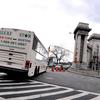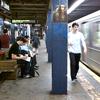Jim O'Grady appears in the following:
The Trash Train
Wednesday, October 26, 2011
Jim O'Grady, WNYC's transit reporter, explains the latest MTA plan to fight litter by removing trash barrels from subway platforms.
New York Conducts Long Distance Bus Inspection Crackdown
Wednesday, October 26, 2011
Long Distance Bus in Manhattan (Sam Lewis/WNYC)
Governor Cuomo's office says 116 bus drivers and 95 buses have been pulled out of service after a two-week roadside inspection blitz by New York state police.
The inspections occurred in late September and early October.
Most of the violations were found on buses in New York City. Almost a third of all bus inspections in the city since March have resulted in a driver or bus being pulled out of service.
The crackdown comes in the long wake of a fatal accident on a Bronx highway on March 12. A tour bus returning from a Connecticut casino in the early morning flipped and rammed into the base of a highway sign, killing 15 people.
Ophadell Williams, the driver in that accident, has been charged with 15 counts of manslaughter. A report by the state inspector general said Williams had a history of moving violations, gave false names to police who pulled him over and lied on his application for a commercial license.
The Governor's office says the New York State Department of Motor Vehicles is now using facial recognition technology to search for drivers who have a valid commercial license in one name and additional license documents in another.
State Inspectors Crack Down on Tour Buses
Wednesday, October 26, 2011

Governor Andrew Cuomo's office said 116 bus drivers and 95 buses had been pulled out of service after a two week roadside inspection blitz by New York state police.
Weehawken Gets Racy: Formula 1 Coming to New Jersey
Tuesday, October 25, 2011
 (New York, NY - WNYC) Weehawken, New Jersey, just got racy. Governor Chris Christie has announced a deal with the London-based Formula 1 racing circuit to hold a Grand Prix event around a 3.2 mile route laid out on local roads in June 2013. Over part of the course, the cars will speed along the edge of the Palisades overlooking the Hudson River with the skyline of Manhattan in the background.
(New York, NY - WNYC) Weehawken, New Jersey, just got racy. Governor Chris Christie has announced a deal with the London-based Formula 1 racing circuit to hold a Grand Prix event around a 3.2 mile route laid out on local roads in June 2013. Over part of the course, the cars will speed along the edge of the Palisades overlooking the Hudson River with the skyline of Manhattan in the background.
Race organizers said, "100,000 people are expected to attend each race, starting with practice on Friday, qualifying on Saturday, and racing on Sunday." They also touted the site's access by PATH train and other forms of mass transit. Local officials said in a statement that no government subsidies were used to land the race, which they estimate will bring "several hundred million dollars to the region annually."
Until now, Weehawken had mainly been known as the place Alexander Hamilton went to be shot to death in a duel with Aaron Burr. Now it will be associated with low-slung, open-wheeled cars racing at an average speed of 185 miles per hour.
Formula 1 holds 19 races a year around the world. The Fédération Internationale de l'Automobile, the sport's race-sanctioning body, says it is "the number one sport worldwide in revenue produced per event, and attracts an audience of 600 million people in 188 counties annually."
The sport has long had its eye on the New York market. Several plans have been floated over the years, including one in the late 1990s for the south shore of Staten Island that called for tens of thousands of spectators to arrive by ferry. Another proposal would've held the race on a mothballed navy base at the other end of the borough. That plan was shot down by residential neighbors fearful of ear-splitting noise from the racing machines.
Note to drivers who find themselves waiting in line at the mouth of the nearby Lincoln Tunnel to Manhattan in June 2013: if the driver next to you is wearing a helmet and steering an open cockpit vehicle, he has strayed from the nearby racecourse and, given the normally sluggish speed of traffic in New Jersey, will not win.
Formula One to Hold Race in New Jersey
Tuesday, October 25, 2011
New Jersey just got racy. Governor Chris Christie formally announced Tuesday that London-based Formula 1 will hold a Grand Prix car race along the New Jersey side of the Hudson in June 2013.
Stats Show NY Subway More Hospitable to Criminals, Perhaps Less So To Rats
Monday, October 24, 2011
The MTA has 10 trash trains like this one to collect garbage overnight from subway stations. (Photo by NotoriousJEN/flickr)
(New York, NY -- WNYC) Crime is increasing in the subway, according to NY Metropolitan Transportation Authority figures. Compared to last year, major felonies are up 17 percent and robberies are up 8.6 percent.
MTA board member Charles Moerdler, speaking to reporters today in a hallway at the MTA's Midtown headquarters, said the steady upward trend in underground crime is troubling.
"These numbers are starting to show there's a terrible concern as to whether there's a parallelism between the downturn in the economy and the upturn in the crime rate," he said.
Subway felonies steadily dropped for over a decade, before beginning to climb in 2009.
But even as crime rises, arrests in the subway are going down: there were 12 percent fewer arrests this year compared to last. Pressed by board members for an explanation, Transit president Tom Prendergast said, "I can't answer that. We'll have to get an answer for you."
Moerdler said that sends a troubling message to straphangers. "My worry is we need to demonstrate that we're on the job. We need to demonstrate a sense of protection."
The discussion came at a meeting of the MTA transit committee, where MTA chief of station operations John Gaito unveiled a program meant to starve rats in the subway by more quickly removing trash from stations--especially discarded food. He said the authority has added two "trash trains" to the eight it already has in service to shorten the amount of time that garbage bags are left for pick-up on platforms.
Workers remove trash from a station overnight by taking thick plastic bags from large metal bins and either stashing them in a storage room or lining them up on a platform for removal by trash train. With more frequent pick-ups, the goal is to have no more smelly or leaking trash bags on platforms awaiting pick-up--and serving as snack food for rodents--each day by 6 a.m. The NY MTA says about 75 bags now await pick-up from platforms each morning. That's down from 107 bags.
The authority removes about 40 tons of garbage a day from the subway. The NY MTA will also test removing trash cans entirely from platforms at two subway stations. The authority hopes the move encourages riders to dispose of their garbage elsewhere.
The initiatives come as 84 percent of subway customers surveyed by the MTA reported being satisfied with the overall comfort and convenience of the subway, up six percentage points from last year.
MTA Unveils Plan to Help Remove Rats From Subways
Monday, October 24, 2011

The MTA unveiled on Monday a new program meant to lower the number of rats in the subway by removing trash from stations.
MTA Delays Dollar Charge On New Metrocards
Monday, October 24, 2011

A controversial plan by the MTA to charge a dollar for a new Metrocard has been put off until at least until January. Programming Metrocard vending machines to charge the fee has turned out to be harder than the authority expected.
Former Cablevision Exec Lhota Tapped as Next MTA Chief
Thursday, October 20, 2011

Governor Andrew Cuomo has nominated Cablevision executive Joseph Lhota to be the next chairman and CEO of the Metropolitan Transportation Authority, the largest transit system in North America.
Cuomo Recommends Foye for Top Port Authority Post
Wednesday, October 19, 2011

Governor Andrew Cuomo has nominated Pat Foye, his deputy secretary for economic development, to be the next executive director of the Port Authority of New York and New Jersey.
Patrick Foye Named New Executive Director of NY-NJ Port Authority
Wednesday, October 19, 2011
Patrick Foye (photo courtesy of the NY MTA)
(New York, NY) Chris Ward’s three-and-a-half year tenure as executive director of The Port Authority of New York and New Jersey has come to an end. Patrick Foye, an aide to Governor Cuomo and a and former state economic development chief, is in.
Ward, 56, was appointed in 2008 by former New York Governor David A. Paterson. He will now be replaced by Patrick Foye, deputy secretary for economic development for New York Governor Andrew Cuomo.
Cuomo announced the appointment in a press release today: "The Port Authority must meet its potential as a major economic engine that plans for the region and attracts business on an international scale. We must also improve its operations and maximize the value out of every dollar spent so that it is financially responsible and respects the tax and toll payers."
Cuomo also said he would propose rolling the Moynihan Station Development Authority and the Lower Manhattan Development Corporation into the Port Authority. The move was immediately endorsed by U.S. Senator Charles Schumer, who has been an advocate of a redeveloped Moynihan Station.
Foye’s most recent job before that was deputy county executive for economic development for Nassau County Executive Ed Mangano. Foye left that job in January after Mangano decided, against Foye’s advice, to sue a state-appointed control board to prevent it from taking over the county’s finances. The county lost the lawsuit.
Foye, a lawyer who worked with Skadden Arps, is a former downstate chairman for New York’s Empire State Development Corporation. Since May 2010, he has sat on the board of the New York Metropolitan Transportation Authority.
Unlike the other transportation post Cuomo has to fill -- head of the New York MTA -- Foye's appointment does not require approval of the New York State Senate.
In an interview, MTA board member Mitch Pally said Foye has been active in his role as the appointee from Nassau County in Long Island. “He’s delved into operating details of the system, communication issues with commuters and fare structure,” Pally said.
In a statement, Foye said "I am honored to be recommended for Executive Director of the Port Authority. Under Governor Cuomo's leadership, we have begun to re-energize New York's economy and pave the way for job growth in the state. I thank Governor Cuomo for this opportunity and look forward to working closely with him and the Board of Directors at the Port Authority on maintaining and improving the New York metropolitan region's vital transportation, infrastructure and economic development assets".
By many accounts, Cuomo and Ward never forged a close working relationship. For example, Cuomo’s schedules show no meetings with the Port Authority executive director during the first eight months of 2011. By contrast Foye, as one of the governor’s deputy secretaries, attended three meetings and a staff reception with Cuomo in the past six months.
Ward’s time leading the authority was marked by controversy and achievement: controversy over recent toll and fare increases on Hudson River crossings; achievement, primarily, for cutting through political and legal disputes to ramp up construction at the stalled World Trade Center site.
In particular, Ward sped up the building of the 9/11 memorial to insure its completion in time for the tenth anniversary of the terrorist attacks. He also helped convince publisher Condé Nast to sign on as a major tenant at 1 World Trade Center, formerly known as The Freedom Tower.
Ward said renaming the anchor skyscraper was crucial to lightening the site’s symbolic weight to focus on more mundane concerns, like construction deadlines. “We were free before 9/11, we were free after 9/11,” he told the New York Times. “New Yorkers don’t need a tower named ‘freedom.’ New Yorkers need to know that we built it, that there’s a place to go and work.”
Ward was less successful in navigating the sharp shoals of toll and fare increases.
He initially proposed to raise toll rates on cash-paying drivers to as much as $15 during peak times, up from $8. He also wanted to hike the PATH commuter train fare by a dollar. What he got—after weeks of criticism from the governors of New York and New Jersey and excoriation from some of the public—was far less. On tolls, he got a $1.50 increase on most drivers beginning last month, and then 75 cents each year for the next four years. On PATH, he got an increase of 25 cents a year for four years.
Ward contended the hikes were necessary to fund the authority’s $33 billion 10-year capital plan, $11 billion rebuilding of the World Trade Center and $6 billion price tag for increased security since the September 11 attacks. Losing that fight left him feeling, in his own words, “burned."
The lower toll hikes means Foye will most likely have to consider cutting some projects from the authority’s capital plan. And that, in the words of the outgoing executive director, will mean: “You’re going to be stuck in traffic on the George Washington Bridge. You’re going to be stuck on buses trying to get into the Port Authority Bus Terminal. You’re going to be stuck at LaGuardia and JFK because [they] don’t have enough runway capacity.”
In the 1990's, Foye, working closely with former U.S. Senator Alfonse D'Amato, helped put together the takeover of the Long Island Lighting Company, or LILCO, by the Long Island Power Authority. LILCO had acquired a huge debt constructing the Shoreham nuclear power plant, which was never opened do to safety concerns.
At the time, the deal involved the biggest issuance of municipal bonds in history.
Cuomo also announced the nominations of two new board members to the Port Authority: James Rubin, a Clinton Assistant Secretary of State, who worked until recently as the executive editor of Bloomberg View, and Rosanna Rosado, the publisher and CEO of El Diario La Prensa.
Chris Ward’s three and a half year tenure as executive director of The Port Authority of New York and New Jersey has come to an end. He announced his resignation today, saying “TK.”
Ward, 56, was appointed in 2008 by former New York Gov. David A. Paterson. He will now be replaced by Pat Foye, deputy secretary for Economic Development for Gov. Andrew Cuomo.
Foye’s most recent job before that was deputy county executive for economic development for Nassau County Executive Ed Mangano. Foye left that job in January after Mangano decided, against Foye’s advice, to sue a state-appointed control board to prevent it from taking over the county’s finances. The county lost the lawsuit.
Foye, a lawyer, is a former downstate chairman for New York’s Empire State Development Corporation. Since May 2010, he has sat on the board of the NY Metropolitan Transportation Authority.
In an interview, MTA board member Mitch Pally said Foye has been active in his role as the appointee from Nassau County in Long Island. “He’s delved into operating details of the system, communication issues with commuters and fare structure,” Pally said.
In a statement, Foye said, “TK.”
By many accounts, Cuomo and Ward never forged a close working relationship. For example, Cuomo’s schedules show no meetings with the chairman of the NY-NJ Port Authority during the first eight months of 2011. By contrast Foye, as one of the Governor’s deputy secretaries, attended three meetings and a staff reception with Cuomo in the past six months.
Ward’s time leading the authority was marked by controversy and achievement: controversy over recent toll and fare increases on Hudson River crossings; achievement, primarily, for cutting through political and legal disputes to ramp up construction at the stalled World Trade Center site.
In particular, Ward sped up the building of the 9/11 memorial to insure its completion in time for the tenth anniversary of the terrorist attacks. He also helped convince publisher Condé Nast to sign on as a major tenant at 1 World Trade Center, formerly known as The Freedom Tower.
Ward said renaming the anchor skyscraper was crucial to lightening the site’s symbolic weight to focus on more mundane concerns, like construction deadlines. “We were free before 9/11, we were free after 9/11,” he told The New York Times. “New Yorkers don’t need a tower named ‘freedom.’ New Yorkers need to know that we built it, that there’s a place to go and work.”
Ward was less successful in navigating the sharp shoals of toll and fare increases.
He initially proposed to raise toll rates on cash-paying drivers to as much as $15 during peak times, up from $8. He also wanted to hike the PATH commuter train fare by a dollar. What he got—after weeks of criticism from the governors of New York and New Jersey and excoriation from some of the public—was far less. On tolls, he got a $1.50 increase on most drivers beginning last month, and then 75 cents each year for the next four years. On PATH, he got an increase of 25 cents a year for four years.
Ward contended the hikes were necessary to fund the authority’s $33 billion 10-year capital plan, $11 billion rebuilding of the World Trade Center and $6 billion price tag for increased security since the September 11 attacks. Losing that fight left him feeling, in his own words, “burned."
The lower toll hikes means Foye will most likely have to consider cutting some projects from the authority’s capital plan. And that, in the words of the outgoing chairman, will mean: “You’re going to be stuck in traffic on the George Washington Bridge. You’re going to be stuck on buses trying to get into the Port Authority Bus Terminal. You’re going to be stuck at LaGuardia and JFK because [they] don’t have enough runway capacity.”
Port Authority Chief Lays Out His Vision for Brooklyn Waterfront
Sunday, October 16, 2011
Chris Ward, executive director of the Port Authority of New York and New Jersey, is stepping down at the end of the month. But, before he leaves his post, he had some final policy recommendations for the Brooklyn Waterfront and Governor’s Island.
NY-NJ Port Authority Chief Confirms He’ll Leave By Month’s End, Lays Out Plan For Brooklyn Waterfront
Friday, October 14, 2011
Chris Ward, head of the Port Authority of New York and New Jersey -- Until Month's End (Stephen Nessen/WNYC)
Chris Ward confirmed he'll be stepping down as executive director of the Port Authority of New York and New Jersey by the end of this month. Ward spoke after giving a speech at a Municipal Arts Society conference in Manhattan.
The fact of Ward’s departure, though not its timing, has been known for a couple of weeks. Ward has used public occasions since then to describe tumultuous episodes in his three-year tenure that had left him feeling “burned” by politics, none more so than the recent bruising fight to raise tolls and fares at Hudson River crossings.
Today he said that topic was off the table, adding that “for those of you who are looking for the parting shot of an executive director, I will not speak ill of where we find ourselves here within this region."
He denied reports that he was leaving his post because of a poor relationship with Governor Cuomo. “I spoke to his staff all the time,” he said. “My relationship with Governor Cuomo didn’t prevent me from doing what I wanted to get done.”
Ward also said he hadn’t arranged his next career move. “Reports that I have a new job are inaccurate,” he said. Neither did he know who might replace him at the Port Authority. Asked whether anyone had mentioned to Ward the idea of running for mayor of New York City, he affirmed, "It has been mentioned."
In his speech, Ward made some final policy recommendations: saying the city should revitalize the Brooklyn waterfront by replacing Red Hook's maritime businesses with a high-capacity ferry to a densely developed Governors Island.
Ward said, “I will state here today, as the outgoing director of the Port Authority, that Governors Island will never realize its full economic potential so long as the Red Hook Container Terminal remains a container terminal.”
Ward used to be CEO of American Stevedoring, the chief maritime business in Red Hook. Now he’d like to see those kinds of operations concentrated in Sunset Park and Bay Ridge.
“There’s a tremendous amount of nostalgia for the Brooklyn waterfront, driven by the idea that container terminals create huge amounts of jobs,” he said. “We have the image of the Brooklyn waterfront of men leaving their homes, kissing their mothers and wives goodbye, carrying their lunch, thousand of them, working on the waterfront. That model is no longer the case.”
He said the Red Hook waterfront should instead serve as a mass transit connection to Governors Island. As for the island, Ward said some parkland and historic structures should be preserved, but the rest of it should be developed in a way that would make it self-sustaining, “or you will face infrastructure and operating costs of 65 to 100 million dollars a year in a city which is desperately trying to close its budget.”
Cuomo Seems To Be Zeroing In On "Surprising" Choice For Next NY MTA Chair
Wednesday, October 12, 2011
Joe Lhota.
(New York, NY) - The committee appointed by New York Governor Cuomo to find the next CEO and chairman of the NY Metropolitan Transportation Authority has completed its work. The governor is now mulling a short list with six names on it, culled from eleven candidates interviewed for the job. Sources familiar with the process say the name at the top of the list is Joseph Lhota, executive vice president of Madison Square Garden and former right hand man to Mayor Rudy Giuliani.
Lhota served in the Giuliani administration for six years, first as budget director and then as deputy mayor of operations. He also worked as an adviser to Giuliani's presidential campaign in 2007-2008.
Other known finalists are NYC Transit President Thomas Prendergast, who oversees 50,000 subway and bus employees; Nuria Fernandez, senior v.p. at an infrastructure management company and former deputy administrator with the Federal Transit Administration; Karen Rae, deputy administrator of the Federal Railroad Administration and a former commissioner of the New York State Transportation Department; and Daniel Grabauskas, the Mitt Romney-appointed general manager of the Massachusetts Bay Transportation Authority who resigned under pressure from Governor Deval Patrick in 2009.
Lhota is considered the leading candidate by those familiar with the search process. Reaction among transit watchers, none of whom would speak on the record to avoid alienating the possible next chief of the NY MTA, was part puzzlement and part wait-and-see.
"I was a little surprised that Joe Lhota rose to the top of that pool," said an official from a previous mayoral administration. "He understands inter-governmental relations and he understands the politics but he’s more of a political operative than a manager."
Both Cuomo and outgoing MTA chairman Jay Walder have said in the past few weeks that the next chair did not need to have a transit background. “I think it is helpful to have a knowledge of mass transit," Walder said at the NY MTA's September board meeting. "I don’t know that it’s an absolutely essential quality.”
Lhota fits that profile. His resume shows no transportation posts. But he did manage large governmental agencies in the Giuliani administration and ran the city when the mayor was out of town. Since then, he has navigated the executive suites of the Cablevision Systems Corporation and Madison Square Garden. And Lhota has served as a board member at the City University of New York for the past ten years. Lhota was one of two board members who did not support withholding an honorary degree from playwright Tony Kushner last May. The vote to table the degree past last spring's commencement was much-criticized and later reversed.
Jonathan Bowles, director of the Center for an Urban Future, a policy think tank, said he didn't know Lhota well enough to comment specifically. But he said that from a leadership perspective, "It’s important someone be selected who can really make a strong case for transit and can convince legislators that this is so critical to the city’s future and that we’re on the precipice of something bad happening."
Bowles added that the stakes are enormous: "If there’s one thing Governor Cuomo could do now to boost the city’s economy, it’s shore up the transit system."
The precipice on which the NY MTA teeters consists of several difficulties: a 2012-2015 capital construction plan with a $10 billion dollar shortfall; a looming contract negotiation with Transport Workers Union Local 100 that, by all signs, will be acrimonious; a threat from a group of state legislators to cut the dedicated revenue stream that is the regional payroll mobility tax, which last year contributed $1.3 billion to authority coffers. That's about an eighth of the authority's operating budget.
Sources differed on Lhota's ability to rise to those challenges. The NY MTA needs someone "who can handle the union relationships, the crisis of money, and Lhota will get it faster than most people," said one. Another thought the Republican Lhota could help the Democrat Cuomo beat back a Republican-lead push in the state legislature to eliminate the payroll mobility tax.
But a third believed Lhota was the front-runner precisely because he won't speak up too loudly for the needs of mass transit: "He’s gong to be the person who makes the cuts without making any demands on the state budget. He may even then turn around and say to the city, 'It’s all your fault.' He’s going to protect Andrew Cuomo from the hard choices."
Earlier today, the governor said at a press conference: “We’re going to have an announcement on the MTA shortly." He added that the public would know his nomination for the chairmanship within “days.” Cuomo has told members of the search committee that he wants to name that person before Jay Walder decamps from the $350,000 a year post on October 21 to run a private rail and real estate company in Hong Kong.
MTA, Transit Union Point Fingers Over Delay in New L Train Service
Wednesday, October 05, 2011

It's going to take eight months for the NY Metropolitan Transportation Authority to add extra weekend service to the over-crowded L train – and the MTA and a major transit union are blaming each other for the delay.
NY MTA & Transit Union Blame Each Other For Delay In New Subway Service
Tuesday, October 04, 2011
Some L trains during rush hour are too crowded to board. (Photo by Runs With Scirssors.)
(New York, NY - WNYC) UPDATED. It's going to take eight months for the NY Metropolitan Transportation Authority to add extra weekend service to the crowded L train, which serves Lower Manhattan and fast-growing parts of Brooklyn. The NY MTA and a major transit union are blaming each other for the delay.
MTA spokesman Charles Seaton said it's a complex operation to revise a subway line's schedule and then allow the union the time it needs, by contract, to pick which workers will crew the new trains.
An email he sent describing the process had at least six steps. They included time for the union to"review and comment on the timetables and work program" and time for the authority to "make modifications agreed to with" the union. And that's only two of the steps.
Seaton said a schedule change like the one proposed for the L train can take up to ten months to implement.
Not necessarily, said Jim Gannon, a spokesman for the Transit Workers Union Local 100. He contended the MTA could add weekend trains on the L line right away by declaring it "supplemental service," as it does for major events like the World Series. Workers-on-call could then crew the trains until the formal process is completed and the schedule change made permanent.
The issue is pressing because over the past twelve years, weekend ridership on the L train has grown at three times the rate of the subway system as a whole, making it the fastest growing subway line. That's according to a new MTA study of the L line requested by State Senator Daniel L. Squadron, a Democrat representing parts of Brooklyn and Manhattan.
"I'm glad the MTA heeded my call to increase weekend service on the L," Squadron said in an email. "Of course, weekend service should be improved as quickly as possible. If there's a way to make it happen earlier within the MTA's budget constraints, then let's make it happen."
A staff member for an elected representative said the MTA called adding L train service outside the formal scheduling process "cost prohibitive." The MTA did not immediately return calls about the the union's call for supplemental service.
Gannon said the burden is on the MTA to provide a timely improvement. "If they wanted to add service on the L line, they could do it," he said. "They’re just being methodical. It seems like they’re pushing the burden of why this takes so long on us."
The Transport Workers Union contract expires in January. The union has had a deteriorating relationship with MTA leadership over the years.
UPDATE: MTA spokesman Charles Seaton emailed with a new reason for why increased weekend L train service can't occur until June 2012. He said the authority plans to spend the first half of next year removing old track-side signals as part of an automated upgrade of the line's signal system, work that needs to happen on the weekends, when trains run less often.
"Remember, the Canarsie Line [L train] is only a two-track railroad," he writes. "We would not want to promise an increase in weekend service and then have to cut service back every weekend while the removals take place."
That means status quo service for L train riders on the weekend until next summer. More riders take the L on Saturday between 1 and 3 p.m. and after 8 p.m. than do during the week at those same times. Late afternoon on Saturday is also when the Brooklyn-bound L sometimes carries up to 35 percent more passengers than the prescribed maximum load, according to the MTA's report. If you must travel to Bushwick at that time for the latest cryptic public art happening, prepare to be squeezed.
2 Struck By Subway Trains
Monday, October 03, 2011

Two subway passengers were struck by trains during the Monday morning commute.
Yankees Fortunes Rise, But Parking Garage Woes Continue
Sunday, September 25, 2011

The New York Yankees are headed to the playoffs. But the company running Yankee Stadium's parking garages remains mired in a slump. With the baseball season just about over, the numbers are in: paying customers have filled only 45 percent of the stadium's 9,000 parking spots on game days this season.
Yankee Stadium Parking Woes Drag On
Friday, September 23, 2011
Empty Yankee Stadium parking garage that could become a hotel and conference center.
(New York, NY - WNYC) The New York Yankees are headed to the playoffs. But the company running Yankee Stadium's parking garages remains mired in a slump. With the baseball season just about over, the numbers are in: paying customers have filled only 45 percent of the stadium's 9,000 parking spots on game days this season.
And now development officials say they are looking to tear down one of the garages and replace it with a first class hotel and conference center. The idea is that development will bring in extra revenue and make the remaining parking spots more valuable.The Yankees argued when seeking city council approval that it's new stadium would require more parking. But the opposite happened.
Many fans who drive to see the Yankees have been shunning the $35 spots for cheaper ones in the neighborhood. Even more fans have been taking the subway or Metro-North trains.
The Bronx Parking Development Company, which owns the eleven garages and surface lots that serve the new Yankee Stadium, built thousands of extra spots. One garage was erected on parkland that New York City, over many residents' objections, gave to the company. The city has worked since then to create an equal amount of parkland in the area, but progress has been slow: the All Hallows High School baseball team, just four blocks from the stadium, has been without a home field for five years.
Heritage Field, a set of regulation-sized baseball diamonds on the lot where the old Yankee Stadium stood, was recently finished. But they still can't be used: another month is needed for the sod to take hold. For now, they sit lushly--and idly--under the sun.
The new Yankee Stadium opened in 2009. Its extensive parking system has underperformed from the start. Now the Bronx Parking Development Company is struggling to pay back the $237 million dollars it owes in tax-exempt bonds.
The company's next bond payment is November 1. Company vice president Chuck Lesnick said he didn't know whether the company will need to dip into its cash serves to meet the obligation, a sign that the enterprise could be teetering on default. Lesnick said in an interview that he'd even be open to selling off surface parking lots around the stadium to raise extra money.
NY Subways Take A Digital Step Forward With "iPad" Informational Kiosk
Tuesday, September 20, 2011
Techno-glee. Press folk crowd a beaming MTA employee at unveiling of On The Go! touch screen at the Bowling Green subway station in Lower Manhattan.
(New York, NY - WNYC) To date, the NY Metropolitan Authority has relied on scratchy public address announcements and regularly vandalized signs to convey information to the subway-riding public. If any system within the system has been poised for a great leap forward, it is this one.
The MTA doesn't have a broad solution for the problem -- but it hopes to alleviate some of the real-time information gap by installing digital kiosks with 47-inch touchscreens in stations. Straphangers will be able to get information in some stations before they go through the turnstile, but not yet on platforms.
The MTA is calling it their version of an iPad. Riders can use a finger to call up travel directions, planned and unplanned service changes and whether the elevators and escalators at their destination station are working.
Other offerings include a map of the neighborhood around the station with walking directions and distances. The time and weather is displayed; a news ticker crawls across the bottom of the the high-definition screen. Third party apps provide local history and shopping and dining options.
NYC Transit spokesman Paul Fleuranges said the digital screens also give the authority the ability to quickly disseminate emergency information. "For example, with an event like Hurricane Irene, we can let people know the subway is shutting down," he said.
The service, called On The Go!, is part of a six-month pilot program that will be adding demonstration kiosks to Penn Station and Grand Central Terminal in Manhattan, Atlantic Avenue / Pacific Street in Brooklyn and Jackson Heights / Roosevelt Avenue in Queens. The authority said a successful pilot would pave the way for installing the screens throughout the system's 468 stations.
The machine's software was developed jointly by NYC Transit and Cisco Systems. Cisco, which had a spokesman at the Bowling Green Station unveiling event, is paying for the pilot. NY MTA officials said they expect the program to generate a steady stream of revenue for from ads displayed on the bottom half of kiosk screens. That income, they said, would also pay for the roll-out of more machines.
















